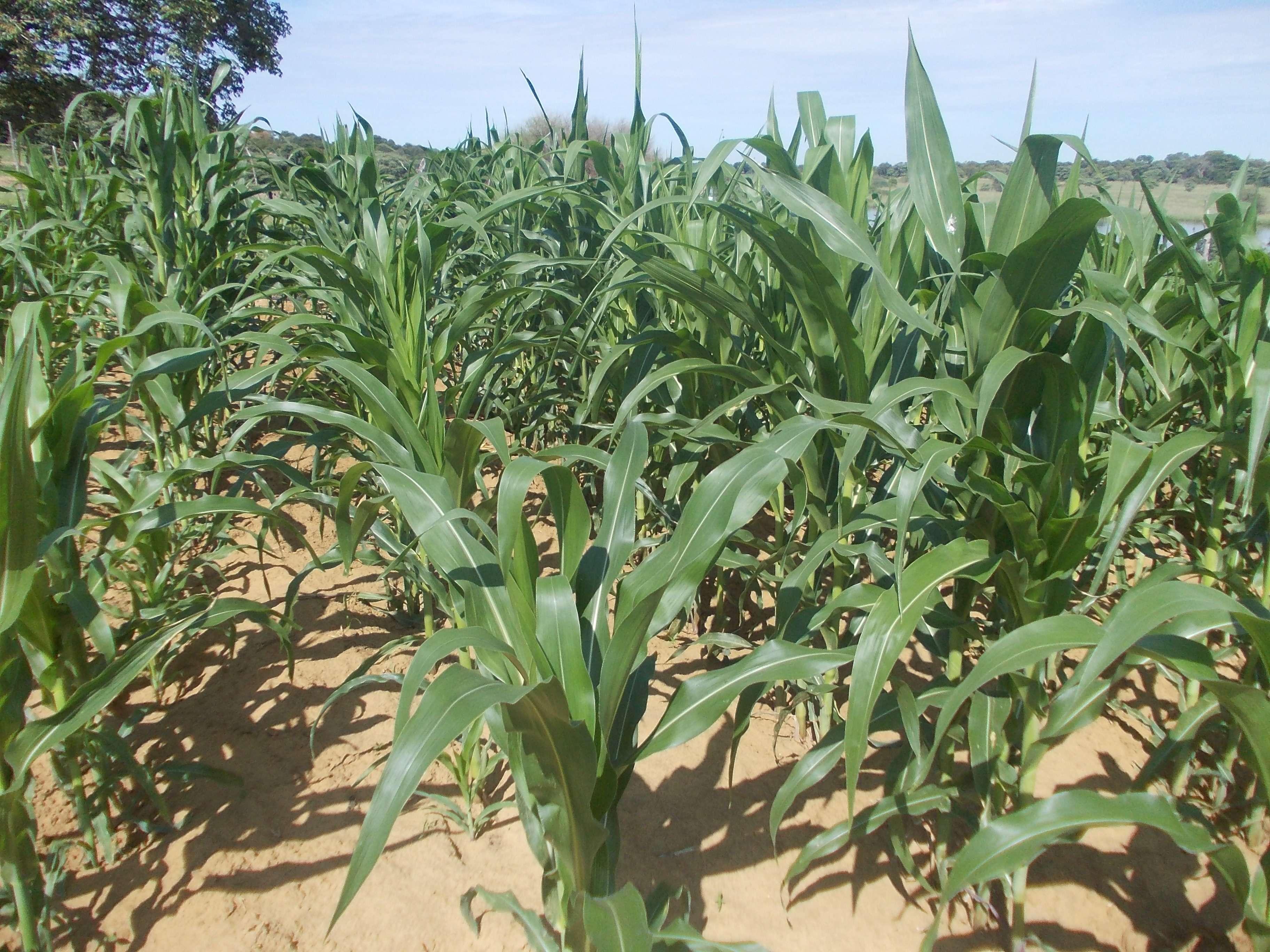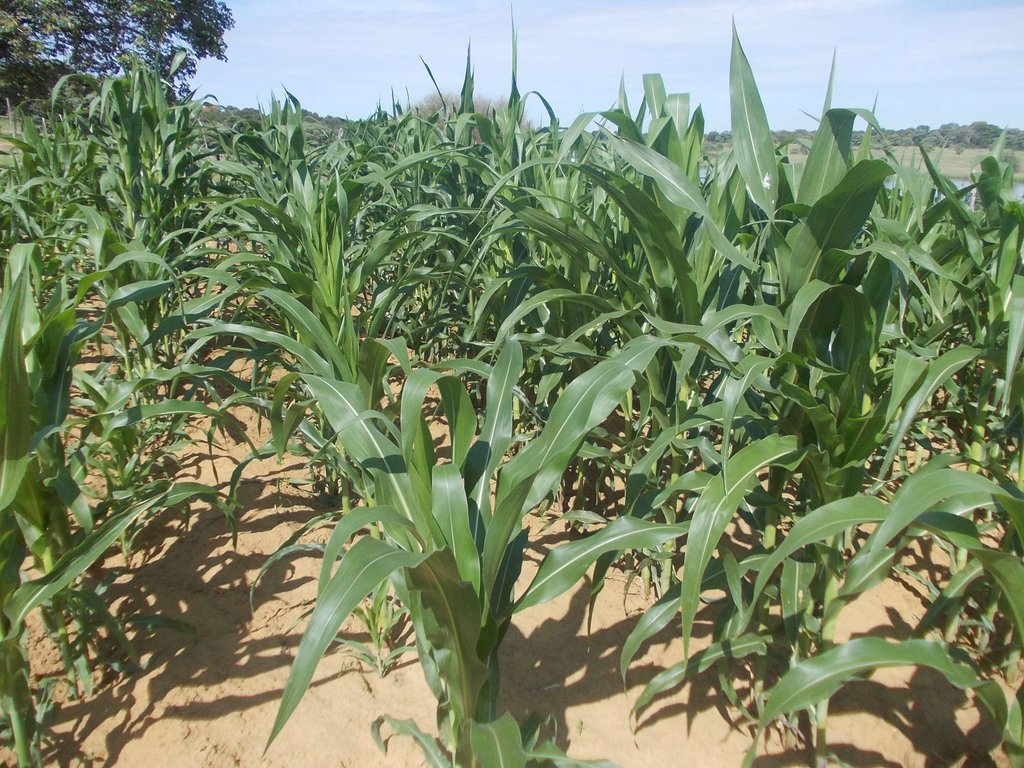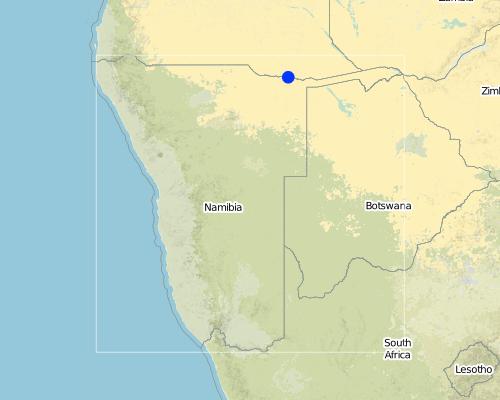Conservation Agriculture in a semi-arid area [纳米比亚]
- 创建:
- 更新:
- 编制者: Alexander Groengroeft
- 编辑者: –
- 审查者: Deborah Niggli, David Streiff
Lima nawa (Vambo/Rukwangali)
technologies_1297 - 纳米比亚
查看章节
全部展开 全部收起1. 一般信息
1.2 参与该技术评估和文件编制的资源人员和机构的联系方式
SLM专业人员:
Simfukwe Maxon
cedpmax@yahoo.com
CEDP
SLM专业人员:
Kowalski Benjamin
+49 6419937043
benjamin.kowalski@agrar.uni-giessen.de
University of Giessen Institute of Agricultural Policy and Market Research Senckenbergstr. 3 35390 Giessen Germany
德国
有助于对技术进行记录/评估的项目名称(如相关)
Book project: Making sense of research for sustainable land management (GLUES)有助于对技术进行记录/评估的项目名称(如相关)
The Future of Okavango (TFO / GLUES)1.3 关于使用通过WOCAT记录的数据的条件
(现场)数据是什么时候汇编的?:
01/03/2001
编制者和关键资源人员接受有关使用通过WOCAT记录数据的条件。:
是
1.4 所述技术的可持续性声明
这里所描述的技术在土地退化方面是否存在问题,导致无法被认为是一种可持续的土地管理技术?:
否
2. SLM技术的说明
2.1 技术简介
技术定义:
Conservation agriculture using permanent water-harvesting planting basins, or rip-lines and fertilizer/manure application on low fertility dryland soils.
2.2 技术的详细说明
说明:
Farmers in north-eastern Namibia practice shifting/semi-permanent subsistence cropping, concentrating on pearl millet cultivation. Here, conservation agriculture (CA) was promoted to sustain and improve production and to reduce conversion of woodland to crops. CA comprises the three principles of minimum soil disturbance, permanent soil cover, and rotation. CA was tested on small plots with volunteers trained by a local NGO. The technology was characterized here by: (i) Early (pre-rains) preparation of the land with two alternative techniques; either: a) basins with a defined spacing opened by a hand hoe, with composted manure added (biochar has also been tested), or b) rip-lines prepared with oxen in lines and with manure application within the rip lines; (ii) Mulching the soil with crop residues, branches or sunnhemp, specially grown for the purpose; (iii) Protection against grazing of crop and mulch by livestock; (iv) Intercropping with vegetables or legumes. (v) Weeding.
CA has been promoted for four seasons, and now trained farmers are transferring their knowledge to others. The technology was promoted to substantially improve the low yields of traditionally practiced agriculture by improving fertility and soil structure as well as better capturing runoff. It was also aimed at avoiding further expansion of croplands into dry woodlands on low fertility arenosols. Eventually it is hoped that the well-being of local subsistence cropping communities will be improved and outmigration reduced.
Knowledge about CA comes from Zambia, where it has been has been practiced successfully for many years by small-scale farmers. A local NGO was engaged by an international project (www.future-okavango.org) which searched for volunteer farmers in the Kavango area. The first CA planting took place in 2011/12. These pioneer farmers were backstopped regularly and the number of farmers trained increased. The NGO monitored crops with contact farmers. 45 more farmers showed interest and were then trained by the contact farmers. Training and backstopping continued until August 2015.
The natural environment is semi-arid. Rainfall is concentrated from November to March. Mean annual precipitation is 570 mm, and mean air temperature is 26.2°C in the hottest month (October) and 16.2°C in the coldest month (July). The landscape forms part of the extended Kalahari basin in central-southern Africa. Deep and extended sands restrict people to living in areas close to surface water. Villages are located along the Okavango on the elevated river terraces – where they produce crops. Here, sedimentation of fine-grained soils, the accumulation of calcium carbonates in the subsoil and the activity of termites have resulted in soils of medium fertility which could potentially ensure yields of 500 kg/ha of millet, if well managed, and assuming good rainfall. Due to the growing population and restricted land availability, cultivation patterns have changed from shifting to semi-permanent and expanded to the adjacent woodlands on the deep Kalahari sands. Here, rapid degradation of soil fertility has caused further expansion and reduced crop yields to very low levels (ca. 150 kg/ha on average). Livestock graze and browse vegetation on the floodplains and in the woodlands. Due to night-time kraaling of livestock, manure is available as fertilizer: thus sustained cropping can be supported. The importance of the woodlands for ecosystem services including timber and firewood, for thatching grass, medicinal plants and biodiversity means they must be conserved and this acts as a reason to support the search for alternative crop production systems such as CA.
2.3 技术照片
2.5 已应用该技术的、本评估所涵盖的国家/地区/地点
国家:
纳米比亚
区域/州/省:
Kavango East
有关地点的进一步说明:
Mashare
注释:
Boundary points of the Technology area: -17.92 / 20.07
-17.89 / 20.28
Map
×2.6 实施日期
如果不知道确切的年份,请说明大概的日期:
- 不到10年前(最近)
2.7 技术介绍
详细说明该技术是如何引入的:
- 通过项目/外部干预
注释(项目类型等):
Introduction in the area by Community Economic Development Programme (CEDP) TFO-project in 2011
3. SLM技术的分类
3.1 该技术的主要目的
- 改良生产
- 减少、预防、恢复土地退化
- 保护生态系统
3.2 应用该技术的当前土地利用类型

农田
- 一年一作

牧场
粗放式放牧场:
- 半游牧/游牧
注释:
Major land use problems (compiler’s opinion): Low and very variable yields per ha; ongoing expansion of fields to less fertile woodlands due to nutrient depletion of originally fertile plots; years with dry spells
Major land use problems (land users’ perception): Crop wilting and poor yields, opening new areas in search of better fields, cutting down trees, slushing and burning residues
Type of cropping system and major crops comments: Under CA, sunhemp for residue and nitrogen fixing has been grown as green manure and fodder for livestock.
3.3 有关土地利用的更多信息
该技术所应用土地的供水:
- 雨养
每年的生长季节数:
- 1
具体说明:
Longest growing period in days: 135, Longest growing period from month to month: Nov to March
牲畜密度(如相关):
1-10 LU /km2
3.4 该技术所属的SLM组
- 土壤肥力综合管理
- 横坡措施
- 集水
3.5 技术传播
具体说明该技术的分布:
- 均匀地分布在一个区域
如果该技术均匀地分布在一个区域上,请注明覆盖的大致区域。:
- < 0.1 平方千米(10 公顷)
注释:
SLM technology was applied by trained smallholders on small plots
3.6 包含该技术的可持续土地管理措施

农艺措施
- A3:土壤表面处理

管理措施
- M2:改变管理/强度级别
注释:
Type of agronomic measures: early planting, mixed cropping / intercropping, mulching, green manure, legume inter-planting, manure / compost / residues, rotations / fallows, minimum tillage, pits
3.7 该技术强调的主要土地退化类型

化学性土壤退化
- Cn:肥力下降和有机质含量下降(非侵蚀所致)

生物性退化
- Bc:植被覆盖的减少
- Bf:火灾的有害影响
- Bl:土壤寿命损失
注释:
Main causes of degradation: soil management (Missing nutrient returns)
Secondary causes of degradation: over-exploitation of vegetation for domestic use (Grazing and burning of crop residues), population pressure (Expansion of croplands to less fertile soils)
3.8 防止、减少或恢复土地退化
具体数量名该技术与土地退化有关的目标:
- 修复/恢复严重退化的土地
4. 技术规范、实施活动、投入和成本
4.1 该技术的技术图纸
4.2 技术规范/技术图纸说明
Scheme of CA field with basins
Within the fenced area, basins are dug per hand-hoe in lines with about 15 cm width, 35 cm length and 15 cm depth and in 70 cm distance. To keep the line and position, a rope with knots every 70 cm is used. Each basin is refilled with 2 cans of manure mixed with part of the soil material. Maize or pearl millet - two stages shown on the graph
Location: Mashare. Kavano East/Namibia
Technical knowledge required for field staff / advisors: moderate
Technical knowledge required for land users: low
Main technical functions: increase in nutrient availability (supply, recycling,…)
Secondary technical functions: increase / maintain water stored in soil, increase of biomass (quantity)
Early planting
Remarks: Planting basins prepared in dry season, planting can occur by first rainfalls (earlier than plough-d
Mixed cropping / intercropping
Material/ species: Maize / Millet /Cowpea
Remarks: Cultivated in parallel lines
Mulching
Material/ species: Grasses & crop residues & sunhemp
Remarks: sunhemp cultivated on the CA field and cut to produce mulch
Green manure
Material/ species: branches of fertilizer tree
Manure / compost / residues
Material/ species: Composted manure from cattle post
Rotations / fallows
Material/ species: Maize / Millet /Cowpea
Remarks: Planted in lines and shifted annually
Minimum tillage
Material/ species: Riplines by oxen
Pits
Material/ species: planting basins by hand hoe
Retention/infiltration ditch/pit, sediment/sand trap
Spacing between structures (m): 0.7
Depth of ditches/pits/dams (m): 0.15
Width of ditches/pits/dams (m): 0.15
Length of ditches/pits/dams (m): 0.35
Structural measure: ripline
Spacing between structures (m): 0.7
Depth of ditches/pits/dams (m): 0.25
Width of ditches/pits/dams (m): 0.1
For water harvesting: the ratio between the area where the harvested water is applied and the total area from which water is collected is: 1:8,3
Change of land use practices / intensity level: More specific soil management; crop protection by fencing; earlier seeding
Major change in timing of activities: To a large part, land preparation can be carried out throughout dry season, independent of rainfall level
4.3 有关投入和成本计算的一般信息
其它/国家货币(具体说明):
Nam $
注明美元与当地货币的汇率(如相关):1美元=:
15.5
4.4 技术建立活动
| 活动 | 措施类型 | 时间 | |
|---|---|---|---|
| 1. | 管理 | dry season |
4.5 技术建立所需要的费用和投入
| 对投入进行具体说明 | 单位 | 数量 | 单位成本 | 每项投入的总成本 | 土地使用者承担的成本% | |
|---|---|---|---|---|---|---|
| 劳动力 | labour | ha | 1.0 | 1104.0 | 1104.0 | 100.0 |
| 施工材料 | Wire for fencing | ha | 1.0 | 224.0 | 224.0 | 100.0 |
| 施工材料 | sticks & poles | ha | 1.0 | 1114.0 | 1114.0 | 100.0 |
| 技术建立所需总成本 | 2442.0 | |||||
注释:
Duration of establishment phase: 3 month(s)
4.6 维护/经常性活动
| 活动 | 措施类型 | 时间/频率 | |
|---|---|---|---|
| 1. | Repairing fences and de-bushing of the fields | 农业学的 | (May - July) |
| 2. | Gatering and spreading of mulch cover | 农业学的 | July - Dec |
| 3. | Cutting sunhemp and applying as additional mulch | 农业学的 | Feb-Mar |
| 4. | Re-digging the planting basins | 农业学的 | August |
| 5. | Manure collection, Planting & fertilizer application | 农业学的 | September - December |
| 6. | Sowing of main crops and sunnhemp and fertilizer application | 农业学的 | November - December |
| 7. | Intercropping with legumes like groundnuts and cowpeas normally two weeks after germination of cereals. | 农业学的 | |
| 8. | Weeding | 农业学的 | |
| 9. | Harvesting | 农业学的 | April - May |
4.7 维护/经常性活动所需要的费用和投入(每年)
| 对投入进行具体说明 | 单位 | 数量 | 单位成本 | 每项投入的总成本 | 土地使用者承担的成本% | |
|---|---|---|---|---|---|---|
| 劳动力 | labour | ha | 1.0 | 848.0 | 848.0 | 100.0 |
| 植物材料 | seeds | ha | 1.0 | 22.0 | 22.0 | 100.0 |
| 肥料和杀菌剂 | fertilizer | ha | 1.0 | 159.0 | 159.0 | 100.0 |
| 肥料和杀菌剂 | compost/manure | ha | 1.0 | 276.0 | 276.0 | 100.0 |
| 施工材料 | Wire for fencing | ha | 1.0 | 220.0 | 220.0 | 100.0 |
| 技术维护所需总成本 | 1525.0 | |||||
注释:
Machinery/ tools: Values above are for manual CA using a hoe; an external worker earns 4 N-$ per working hour; above, family labour was multiplied by 4 to estimate the “value” of the family labour invested
The costs are based on labour needs of one year and 500 kg/ha of fertilizer
4.8 影响成本的最重要因素
描述影响成本的最决定性因素:
CA was designed to require minimal financial investments; theoretically, everything apart from wire for the fences and inorganic fertilizer can be created or gather by the household. This turns CA into a very labour intensive farming practice. The high Dollar values above result from multiplying the (free) family labour invested in farming with the typical hourly wage rate of an external worker
5. 自然和人文环境
5.1 气候
年降雨量
- < 250毫米
- 251-500毫米
- 501-750毫米
- 751-1,000毫米
- 1,001-1,500毫米
- 1,501-2,000毫米
- 2,001-3,000毫米
- 3,001-4,000毫米
- > 4,000毫米
农业气候带
- 半干旱
Thermal climate class: subtropics
5.2 地形
平均坡度:
- 水平(0-2%)
- 缓降(3-5%)
- 平缓(6-10%)
- 滚坡(11-15%)
- 崎岖(16-30%)
- 陡峭(31-60%)
- 非常陡峭(>60%)
地形:
- 高原/平原
- 山脊
- 山坡
- 山地斜坡
- 麓坡
- 谷底
垂直分布带:
- 0-100 m a.s.l.
- 101-500 m a.s.l.
- 501-1,000 m a.s.l.
- 1,001-1,500 m a.s.l.
- 1,501-2,000 m a.s.l.
- 2,001-2,500 m a.s.l.
- 2,501-3,000 m a.s.l.
- 3,001-4,000 m a.s.l.
- > 4,000 m a.s.l.
5.3 土壤
平均土层深度:
- 非常浅(0-20厘米)
- 浅(21-50厘米)
- 中等深度(51-80厘米)
- 深(81-120厘米)
- 非常深(> 120厘米)
土壤质地(表土):
- 粗粒/轻(砂质)
- 中粒(壤土、粉土)
表土有机质:
- 中(1-3%)
- 低(<1%)
5.4 水资源可用性和质量
地下水位表:
5-50米
地表水的可用性:
匮乏/没有
水质(未处理):
良好饮用水
5.5 生物多样性
物种多样性:
- 中等
5.6 应用该技术的土地使用者的特征
生产系统的市场定位:
- 生计(自给)
非农收入:
- 收入的10-50%
相对财富水平:
- 贫瘠
- 平均水平
个人或集体:
- 个人/家庭
机械化水平:
- 手工作业
- 畜力牵引
性别:
- 女人
- 男人
说明土地使用者的其他有关特征:
Land users applying the Technology are mainly common / average land users
Population density: 10-50 persons/km2
Annual population growth: 1% - 2% (One farmer to our knowledge could be considered wealthy). (Few average farmers). (Mostly CA farmers are poor).
5.7 应用该技术的土地使用者拥有或租用的平均土地面积
- < 0.5 公顷
- 0.5-1 公顷
- 1-2 公顷
- 2-5公顷
- 5-15公顷
- 15-50公顷
- 50-100公顷
- 100-500公顷
- 500-1,000公顷
- 1,000-10,000公顷
- > 10,000公顷
这被认为是小规模、中规模还是大规模的(参照当地实际情况)?:
- 小规模的
5.8 土地所有权、土地使用权和水使用权
土地所有权:
- 州
- 社区/村庄
土地使用权:
- 社区(有组织)
用水权:
- 社区(有组织)
注释:
parallel existence of state and communal laws
5.9 进入服务和基础设施的通道
健康:
- 贫瘠
- 适度的
- 好
教育:
- 贫瘠
- 适度的
- 好
技术援助:
- 贫瘠
- 适度的
- 好
就业(例如非农):
- 贫瘠
- 适度的
- 好
市场:
- 贫瘠
- 适度的
- 好
能源:
- 贫瘠
- 适度的
- 好
道路和交通:
- 贫瘠
- 适度的
- 好
饮用水和卫生设施:
- 贫瘠
- 适度的
- 好
金融服务:
- 贫瘠
- 适度的
- 好
6. 影响和结论性说明
6.1 该技术的现场影响
社会经济效应
生产
作物生产
收入和成本
农业投入费用
注释/具体说明:
not measured but assumed
农业收入
工作量
注释/具体说明:
not measured but assumed
社会文化影响
食品安全/自给自足
健康状况
文化机会
娱乐机会
冲突缓解
注释/具体说明:
Envy and gossip were observed
社会经济弱势群体的情况
contribution to human well-being
注释/具体说明:
Improved and stabilized yields help rural families to adapt to modern lifestyles. However, the long-term contribution of CA to the well-being of the local farmers cannot be foreseen. The establishment of family-owned fenced areas for crop production is likely to have an influence on the social structure of the rural communities.
生态影响
水循环/径流
蒸发
注释/具体说明:
not measured but assumed
土壤
土壤水分
注释/具体说明:
not measured but assumed
土壤覆盖层
注释/具体说明:
not measured but assumed
养分循环/补给
注释/具体说明:
not measured but assumed
土壤有机物/地下C
注释/具体说明:
not measured but assumed
6.3 技术对渐变气候以及与气候相关的极端情况/灾害的暴露和敏感性(土地使用者认为的极端情况/灾害)
气候有关的极端情况(灾害)
气候灾害
| 该技术是如何应对的? | |
|---|---|
| 干旱 | 好 |
注释:
Dig basins at 20cm (0.20m) deep; and extra water harvesting basins at 0.45m in-between the rows. For the ox-ripped lines, use ripper wings to open a wider farrow for water harvesting
6.4 成本效益分析
技术收益与技术建立成本相比如何(从土地使用者的角度看)?
短期回报:
轻度消极
长期回报:
积极
技术收益与技术维护成本/经常性成本相比如何(从土地使用者的角度看)?
短期回报:
中性/平衡
长期回报:
积极
6.5 技术采用
注释:
SLM Technology has been applied by own interest of smallholders
100% of land user families have adopted the Technology without any external material support
There is a strong trend towards spontaneous adoption of the Technology
6.7 该技术的优点/长处/机会
| 土地使用者眼中的长处/优势/机会 |
|---|
| Saves labour over time |
| Can use less land compared to conventional system for the same harvest/yield |
| 编制者或其他关键资源人员认为的长处/优势/机会 |
|---|
| A strength of the system is the timely land preparation |
| The advantage of permanent planting stations results from the higher availability of nutrients to crop roots. |
| The moisture retention within the rooting space is improved by the surface structure and the increase in soil organic matter |
| The rotations of crop rotations is encouraged |
| All inputs can be used precicely, there is less wastage of inputs |
6.8 技术的弱点/缺点/风险及其克服方法
| 土地使用者认为的弱点/缺点/风险 | 如何克服它们? |
|---|---|
| The weed management is labour intensive and the impact of pests might be a future challange. | The application of more mulch and the weeding regularly in the first part of the season is supposed to reduce weeds. |
| 编制者或其他关键资源人员认为的弱点/缺点/风险 | 如何克服它们? |
|---|---|
| To start with this technology is labour intensive at the beginning. In this moment, the hard pan caused by years of ploughing has to be loosened. | Because the basins/riplines are permanently maintained in CA, the preceding land preparations become easier. Also since land preparation starts before on-set of rains, one can spread labour by starting just after harvesting crop |
| There is a general problem of constructing fences around fields in communal lands, as state authorities declare this land as being owned by the state. | By agreeing with the local leadership to allow those doing CA to fence off their fields for proper keeping of residues and basins/riplines that might be prone to free livestock grazing after crop harvests. |
7. 参考和链接
7.1 信息的方法/来源
- 实地考察、实地调查
- 与土地使用者的访谈
7.2 参考可用出版物
标题、作者、年份、ISBN:
Groengroeft, A., et al. (2013) A method for yield assessment on rainfeld dryland agricultural fields.
可以从哪里获得?成本如何?
Biodiversity & Ecology 5:279 - 286
标题、作者、年份、ISBN:
Kowalski, B. et al. (2013) Mashare - The People.
可以从哪里获得?成本如何?
Biodiversity & Ecology 5:121-128
标题、作者、年份、ISBN:
Pröpper, M. et al. (2010) Causes and perspectives of land-cover change through expanding cultivation in Kavango.
可以从哪里获得?成本如何?
Biodiversity in southern Africa. Volume 3: Implications for landuse and management, eds. M. T. Hoffman, U. Schmiedel and N. Jürgens. Göttingen & Windhoek: Klaus Hess Publishers.
标题、作者、年份、ISBN:
Pröpper, M. et al. (2015) The Future Okavango – Findings, Scenarios and Recommendations for Action.
可以从哪里获得?成本如何?
Research Project Final Synthesis Report 2010-2015, 190. Windhoek: University of Hamburg
链接和模块
全部展开 全部收起链接
无链接
模块
无模块






